
Create an Amazon Business Account



Herbert O. Fisher is one of those people who generally went unnoticed. That
is until he climbed into the cockpit of an airplane. A test pilot for Curtiss
Wright since 1937, Fisher’s reputation was such that he was offered many of
the company’s more difficult test programs. His work during World War Two
was so remarkable, that he was the only civilian pilot to be awarded the
USAAF’s Air Medal. This award was pinned onto his suit jacket by President
Roosevelt during a special White House ceremony.
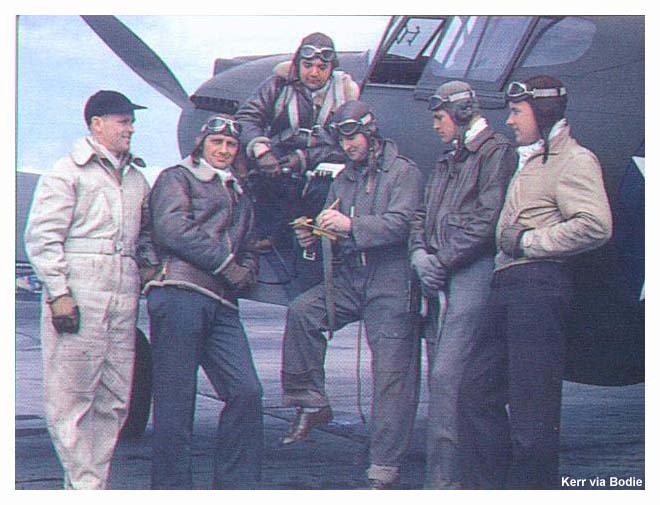
With the surrender of Japan, aircraft production contracts were slashed to the bone, with some being cancelled outright. Curtiss was one of the companies whose production slowed dramatically. With much less test flying being done, Fisher and his considerable talents were transferred to the Propeller Division of Curtiss Wright. At the time, much effort was being expended on researching supersonic propellers. Curtiss was investigating ways to overcome the loss of efficiency that accompanies the propeller tips exceeding the speed of sound. If it were possible to engineer a propeller that could maintain its efficiency at transonic speeds, the performance of conventional aircraft could be enhanced significantly. Or, that was the hope at least. Since the early years of the war, propeller technology had advanced considerably. Let’s take some space and review propeller development during the war.
In some respects, Germany had led the way in propeller design by introducing wide, broad chord blade propellers. If one looks at the narrow chord blades of the Luftwaffe’s Bf 109E fighter and compares these to the later Bf 109G, it is readily apparent that the latter’s propeller blades have widened considerable. The earlier VDM, variable pitch propeller worked reasonably well at converting the Daimler-Benz 601 engine’s power into thrust. However, as the weight and drag of subsequent models increased, so did the horsepower requirements. With the increased power came the need to utilize that power in a more efficient manner. Thus, German engineers looked to the propeller design as the solution to getting the power to the road, to use the common metaphor. Ultimately, these engineers decided to remain with three blades, rather than four (or more) as incorporated by British and American designers. It must be assumed that the efficiency of their design did not require more than three blades. Perhaps the penultimate example of the German three-blade design resides in those used on late war fighters such as the Fw 190D and the Ta 152. Indeed, the chord to span ratio of these propellers is dramatic in comparison to the “toothpick” blades used on virtually every fighter in the American inventory through 1942. Another noteworthy observation of the German designs shows us that the propeller blades were not “clipped”, or squared off. The blades have a semi-elliptical trailing edge that tapers to a tight radius at the tip. There can be little doubt that this shape was found to be acceptable. Yet, one must speculate if, somehow, the German designers had missed the boat. Consider the enormous amount of power produced by the late war DB 605A and the Jumo 213A engines, producing up to 1,800 and 2,240 horsepower respectively. Now, compare that with the performance of the fighters in which they were installed. The fastest sub-model of the Bf 109G could do no better than 428 mph. Likewise the much-touted Fw 190D could manage but just 426 mph. When we look at the North American P-51D, we see a fighter that was at least 10 mph faster on 300 to 600 fewer horsepower. Granted, the superlative P-51 was a remarkably low drag design. Nonetheless, had the Germans found themselves on the backside of the power vs efficiency curve again? I believe that we can say that the answer is yes.
Exactly what the process was that led the American propeller manufacturers to develop “high activity”, paddle blade props is uncertain. What is known is that complaints from combat units about poor acceleration and climb caused the aircraft industry as a whole to evaluate how horsepower was being converted into motive thrust. One of the earliest developments saw the installation of “cuffs” at the base of each blade to improve airflow to the engine. These cuffs performed very much like a cooling fan and did aid in reducing the operating temperature of the large radial engines. However, the value of the cuffs was dubious at best when installed on aircraft with liquid cooled powerplants. Indeed, the Aeroproducts prop installed on the P-51K (essentially a P-51D built in the Dallas factory) did not incorporate cuffs and performance was not effected to any measurable degree.
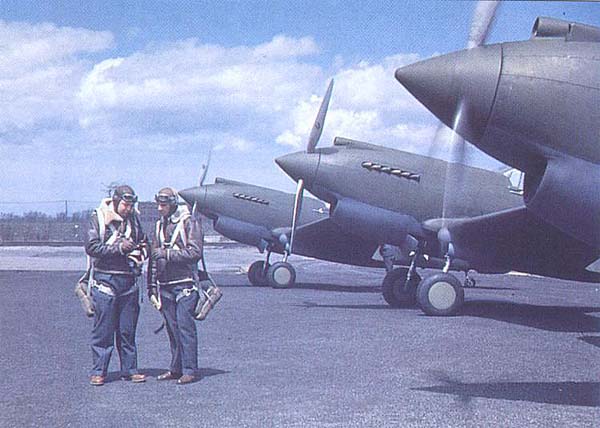
Ultimately, the propeller designers gradually turned to blades of greater chord.
Moreover, that chord was extended closer to the propeller hub, blending into the
cuffs on the Hamilton Standard 24D50-65 installed on the Mustang. Curtiss Electric props
incorporated increased chord, but they narrowed down to the reverse taper of the cuff.
By their appearance, the new prop blade designs did present more than a passing likeness
to a canoe paddle. Hence the term, “paddle blades”. One striking
difference between the American propellers and those of Germany was
that the “paddle blades” were more of constant chord taper. Whereas
the Germans utilized a more pronounced taper leading to the tip. It
might be speculated that the German designers did not want to place
the greatest width of the prop near the tip. Reasoning for this may
be that it made little sense to do that because of the great loss of
efficiency when the tip velocity approached the speed of sound.
Therefore, the greatest width of chord can be seen at the mid-section
of the blade. However, one must wonder how much thrust was sacrificed
by tapering the trailing edge so much when the loss of efficiency was
likely no greater with Aeroproducts constant chord, squared tip design.
Certainly, by 1944, the Americans and British had not only caught up
with the Germans in propeller design, but probably had surged ahead.
After the war, the development of propellers did not cease. Even with the introduction of turbojet powered aircraft, propeller design evolved. The desire to develop a propeller that maintained its efficiency at transonic speeds led the Curtiss Propeller Division to design and test several different concepts. Herb Fisher was the logical choice to fly the test aircraft. Curtiss was able to obtain a P-47D-30-RE from the Air Corps. Fitted with one of several different “supersonic” propellers, Fisher undertook a long and risky flight test program that incorporated high Mach dives from high altitudes. Typically, Fisher would climb above 35,000 ft. He would then push over into a steep dive, allowing his airspeed to build beyond 560 mph (true airspeed). He would then execute a pullout at 18,000 ft. Several of these dives resulted in speeds of Mach .83. However, that was as fast as the P-47 could go.
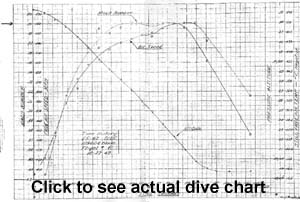
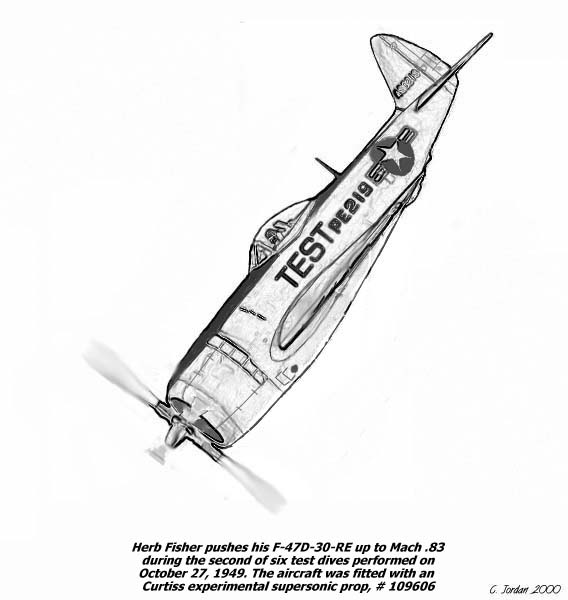 |
Ultimately, all of Fisher’s test dives provided a great deal of data that was becoming superfluous even while the testing continued. Without question, all future fighter designs would be powered by jet engines. The final attempt to construct a supersonic, propeller driven fighter, Republic’s XF-84H (accurately nicknamed the Thunderscreech), failed to achieve its purpose. Yet, it was without doubt, the fastest prop driven aircraft ever to fly.
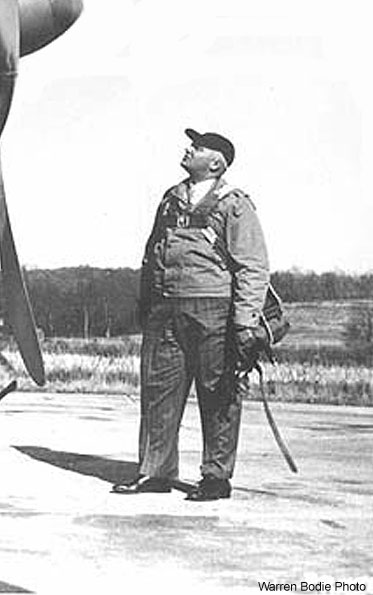 |
Fisher’s propeller work was not limited to transonic props. He also conducted a great deal of testing with reversible pitch designs. It was this testing that produced a safe method of rapid descent for airliners. Flying a Douglas C-54, Fisher would reverse the pitch of all four engines simultaneously. He would then push the nose over and maintain a rate of descent that exceeded 15,000 ft/min., yet forward airspeed was well within normal parameters (200 mph) and there was no decrease in controllability. Fisher wrote that he would be flying at 15,000 ft., three miles from the field and be stopped on the runway in one minute and fifty seconds! This method was demonstrated for Hap Arnold and Dwight Eisenhower in 1948. In total, Fisher performed nearly 200 of these high rate/low speed descents during the program’s life. Herb had developed a usable method of safely dumping altitude in the event of an emergency. Fisher was also instrumental in developing the use of reversing pitch to rapidly slow an aircraft, which allowed them to land safely on shorter runways, and in general, greatly reduce the incidence of runway overruns.
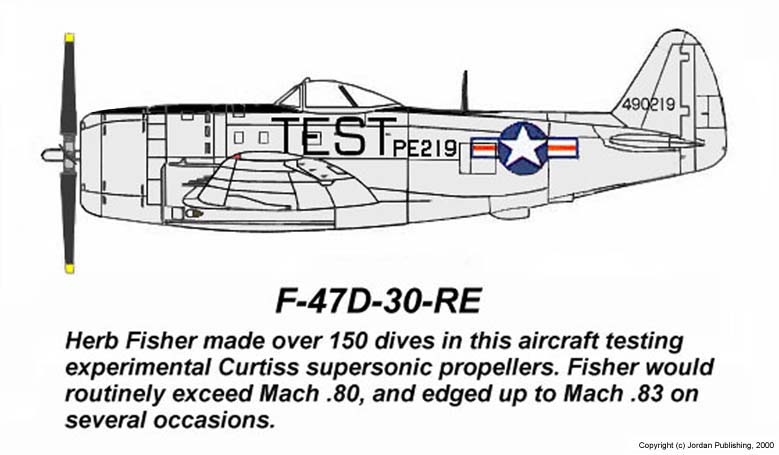
Eventually Fisher would leave Curtiss, but continued to work in aviation, becoming one of the country’s most renowned experts on aviation matters. The entire story of his career is just as remarkable as his work with propellers. That story will be told in a major aviation magazine in the near future. For now, the reader need only understand that Herb Fisher was a quiet and unassuming man, who did not seek the limelight. However, he was a giant in his field and a true pioneer of American aviation.
